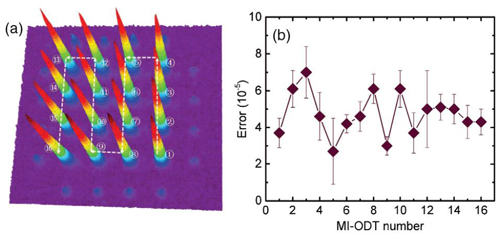|
|
CAS Scientists Realize High-Fidelity Single-Qubit Gates on Neutral Atoms |
A key progress in the study of quantum information processing with optically trapped neutral atoms was realized by Prof. ZHAN Mingsheng’s group from Wuhan Institute of Physics and Mathematics (WIPM) of Chinese Academy of Sciences.
Zhan’s team utilized the magic-intensity optical trapping technique to construct a novel atomic quantum register, in which the fidelity of global single-qubit gates was achieved higher than 99.99% for the first time. This fidelity surpasses the commonly accepted error threshold per gate ( 10-4) for quantum fault tolerance computation. This work was published in the Journal of Physical Review Letters.
Neutral atoms in optical dipole trap (ODT) arrays, when serving as quantum bits (qubits), are believed to have outstanding scalability for quantum simulation and quantum computation. As a conventional approach, ODT arrays with linear polarization have been widely used to assemble neutral-atom qubits for building a quantum computer.
However, due to the inherent scalar differential light shifts (DLS) of qubit states induced by trapping fields, the microwave-driven gates acting on single qubits suffer from errors on the order of 10-3. It is thus crucial to construct such an ODT array in which the detrimental DLS of qubits can be effectively compensated so that one can implement high performance microwave-driven gates with errors per gate bellow 10-4.
Zhan’s team constructed a DLS compensated ODT array based upon a recently developed magic-intensity trapping technique. In such a magic-intensity optical dipole trap (MI-ODT) array, the detrimental effects of DLS are efficiently mitigated so that the performance of global microwave-driven Clifford gates is significantly improved. Experimentally, they achieved an average error of (4.7±1.1)× 10-5 per global gate, which is characterized by randomized benchmarking in a 4×4 MI-ODT array.
Their work shows that MI-ODT array is a versatile platform for building scalable quantum computers with neutral atoms. This work, together with their previous demonstration of the coherent transfer of a mobile qubit and the entanglement of two individual atoms of different isotopes via Rydberg blockade, represents key steps towards a scalable quantum computer with neutral atoms trapped in MI-ODT arrays.
This work was supported by the National Key Research and Development Program of China, the National Natural Science Foundation of China and the Strategic Priority Research Program of the Chinese Academy of Sciences. 
Array experiments. (a) The 4*4 profiels of MI-ODT array with 5.2 mu intersite spacing. Each site of the array is labeled from 1 to 16. The dashed arrows indicate the path of scanning. (b) The recorded values of error per gate as a function of site number. (Image by WIPM) Contact :ZHAN Mingsheng, mszhan@wipm.ac.cn
|
|
|